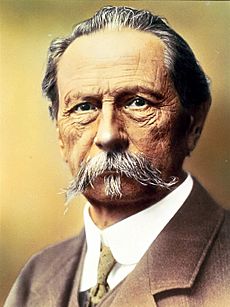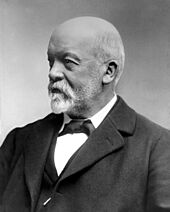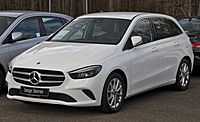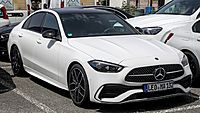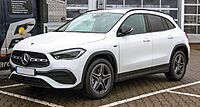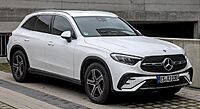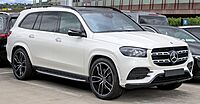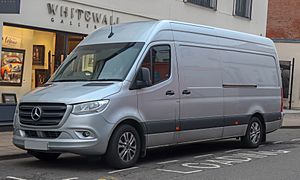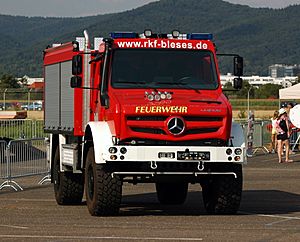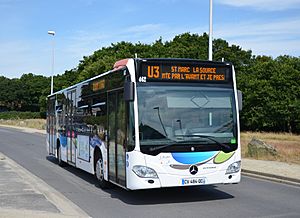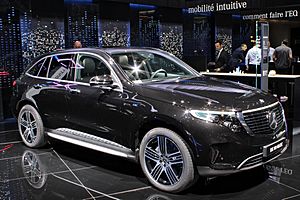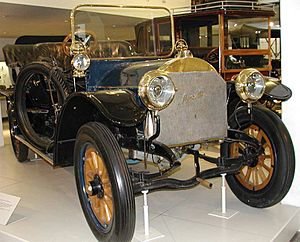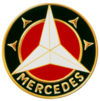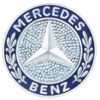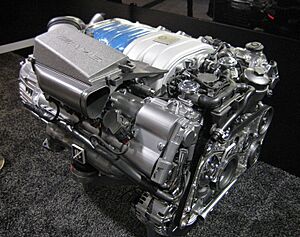Mercedes-Benz facts for kids
 |
|
| Type | Automotive |
|---|---|
| Owner |
|
| Country | Germany |
| Introduced | 28 June 1926 |
 |
|
| Subsidiary | |
| Industry | Automotive |
| Predecessor | Mercedes-Benz division of Daimler AG |
| Founded | November 2019 |
| Headquarters |
,
Germany
|
|
Area served
|
Worldwide |
|
Key people
|
Ola Källenius (chairman of the board of management and CEO) |
| Products |
|
| Brands |
|
|
Production output
|
2,164,187 cars worldwide (2020) |
| Services | |
| Parent | Mercedes-Benz Group |
| Divisions |
|
| Subsidiaries |
|
Mercedes-Benz is a famous German car brand. People often just call it Mercedes or Benz. It was started in 1926. Mercedes-Benz AG, a part of the Mercedes-Benz Group, makes fancy cars and small vans. Their main office is in Stuttgart, Germany.
Since November 2019, another company called Daimler Truck has made the big trucks and buses that carry the Mercedes-Benz name. Daimler Truck became its own company at the end of 2021.
In 2018, Mercedes-Benz became the biggest luxury car brand in the world. They sold over 2.3 million passenger cars that year.
The brand's history goes back to the first cars ever made. These include the 1901 Mercedes car and the 1886 Benz Patent-Motorwagen. This early car, made by Carl Benz, is known as the first car with a gasoline engine. Mercedes-Benz's slogan is "The Best or Nothing."
Contents
The Story of Mercedes-Benz
The story of Mercedes-Benz began with two inventors: Karl Benz and Gottlieb Daimler. Karl Benz made the first car with an internal combustion engine in 1886. It was called the Benz Patent-Motorwagen. Around the same time, Gottlieb Daimler and his engineer Wilhelm Maybach put a gasoline engine into a horse-drawn carriage.
The "Mercedes" car was first sold in 1901 by a company called Daimler Motoren Gesellschaft (DMG). An Austrian businessman named Emil Jellinek-Mercedes worked with DMG. He registered the "Mercedes" name as a trademark in 1902. He named the 1901 Mercedes 35 hp car after his daughter, Mercedes Jellinek.
Jellinek was good at selling cars to rich people. He even sold Mercedes cars in America to famous families like the Rockefellers. At a race in 1899, Jellinek used the name "Monsieur Mercédès" when he drove. Many people think this race was the real start of the Mercedes-Benz brand. In 1901, "Mercedes" became a protected trademark all over the world.
The first cars with the "Mercedes-Benz" name were made in 1926. This happened after Karl Benz's company and Gottlieb Daimler's company joined together. They formed the Daimler-Benz company on June 28, 1926.
During the 1930s, Mercedes-Benz made the 770 model car. Some of these cars were used by important leaders at the time. One of these cars is now in the Canadian War Museum in Ottawa, Canada.
After 1937, Daimler Benz started making more military vehicles and airplane engines. By 1942, they mostly stopped making cars and focused on war production. The company later paid money to families of people who were forced to work for them during this time.
In 1958, Mercedes-Benz started working with an American car company called Studebaker to sell cars in the United States.
Over the years, Mercedes-Benz has created many new technologies and safety features. Many of these features later became common in other cars. Today, Mercedes-Benz is one of the most famous car brands in the world. Even the Pope's special car, the Popemobile, has often been a Mercedes-Benz.
In November 2019, Daimler AG announced that Mercedes-Benz would become its own separate company called Mercedes-Benz AG. This new company would handle Mercedes-Benz cars and vans. Trucks and buses with the Mercedes-Benz name became part of the Daimler Truck AG company.
In May 2022, Mercedes-Benz sold a very rare 1955 Mercedes-Benz SLR car for $142 million. This was the most expensive car ever sold at that time. The money from the sale was used to start the Mercedes-Benz Fund.
In June 2022, Mercedes-Benz recalled almost one million vehicles made between 2004 and 2015. This was because of possible problems with their braking system.
Mercedes-Benz Companies and Partnerships
The Mercedes-Benz Cars part of the company now handles the making of Mercedes-Benz and Smart cars.
Mercedes-AMG: High-Performance Cars
Mercedes-AMG became a big part of Mercedes-Benz in 1999. This division makes very powerful and sporty versions of Mercedes-Benz cars. Each AMG engine is built by hand, and the engineer who built it signs a tag on the engine.
Mercedes-Maybach: Super Luxury Cars
The super-luxury Maybach brand used to be separate, but its production stopped in 2012. Now, it's part of Mercedes-Maybach. These models are extra luxurious versions of regular Mercedes-Benz cars, like the Mercedes-Maybach S600 and the Mercedes-Maybach GLS 600 SUV.
Mercedes-Benz in China
Daimler worked with a Chinese company called BYD Auto to make an electric car called Denza. However, the Mercedes-Benz Group is no longer involved with Denza. Mercedes-Benz also works with BAIC Group in a company called Beijing Benz to make Mercedes-Benz cars in China.
Mercedes-Benz in Vietnam
Mercedes-Benz Vietnam started in 1995. It's a partnership that assembles different Mercedes-Benz models in Ho Chi Minh City. The factory upgraded its technology in 2021-2022 to prepare for assembling AMG models. The 1996 Mercedes E230 was the first model made at this factory.
Where Mercedes-Benz Cars are Made
Mercedes-Benz vehicles are made or put together in many countries around the world, not just in Germany.
| Sovereign state | Continent | Note |
|---|---|---|
| Africa | Makes buses and trucks. | |
| South America | Makes buses, trucks, and vans. This was the first Mercedes-Benz factory outside Germany, built in 1951. | |
| Australia | Some models were put together here from 1959 to 1965. | |
| Europe | Makes the G-Class. | |
| South America | Makes trucks and buses. Started in 1956. | |
| North America | Has a fuel cell plant in Burnaby, opened in 2012. | |
| Asia | Beijing Benz makes many Mercedes-Benz car models for the Chinese market. | |
| Africa | Makes E-Class, C-Class and GLK cars. | |
| Europe | Valmet Automotive makes the new A-series cars since late 2013. | |
| Europe | Has a factory in Kecskemét, making B-Class and CLA cars. | |
| Asia | Has factories in Pune and Chennai for cars, buses, trucks, and engines. | |
| Asia | Makes many car models. | |
| Asia | Puts together C, E, and S class vehicles. | |
| North America | Makes many Mercedes and Daimler vehicles. | |
| Africa | Puts together buses, trucks, and vans. | |
| Eurasia | Makes trucks and vans. | |
| Africa | Has a factory in East London, making C-class cars for both right and left-hand drive. | |
| Asia | Some Mercedes-Benz models were made by SsangYong Motor Company. | |
| Europe | Factory at Vitoria-Gasteiz makes Mercedes-Benz Vito, Viano, and V-Class vans. | |
| Asia | Puts together many car models, including some AMG models. | |
| Eurasia | Makes some Mercedes-Benz buses. | |
| Europe | The SLR sports car was built here. Also home to the Mercedes Grand Prix factory. | |
| North America | The Mercedes-Benz GLE-Class, GL-Class, and C-Class vehicles are built near Tuscaloosa, Alabama. | |
| Asia | Puts together E-Class, C-Class, S-Class, GLK-Class, and Sprinter vans. Started in 1995. |
Car Quality and Reliability
Before the mid-1990s, Mercedes-Benz cars were known for being very high quality and lasting a long time. Owners often called them "tanks" because they seemed so strong.
In recent years, surveys like those by J. D. Power have shown that Mercedes-Benz has improved its quality. In 2007, Mercedes jumped from 25th to 5th place in a study about problems in the first 90 days of owning a car. By 2008, they were in 4th place. Studies in 2011 also showed Mercedes-Benz vehicles were above average in how well they were built and how reliable they were.
Mercedes-Benz Car Models
Mercedes-Benz makes many different types of vehicles. These include cars for everyday use, light vans, and heavy trucks. The Smart brand of small city cars is also made by Daimler AG.
Current Car Models
- A-Class – A small hatchback or sedan.
- B-Class – A small family car.
- C-Class – A compact luxury car, also available as a wagon, coupe, or convertible.
- CLA – A stylish sedan or wagon.
- CLE – A luxury coupe or convertible.
- E-Class – An executive car, also available as a wagon.
- G-Class – A rugged off-road vehicle.
- GLA – A compact SUV.
- GLB – A mid-size SUV.
- GLC – A compact luxury SUV.
- GLE – A mid-size luxury SUV.
- GLS – A large luxury SUV.
- S-Class – A full-size luxury sedan, also available as a coupe or convertible.
- T-Class – A compact family van.
- V-Class – A large family van.
- AMG GT – A sporty coupe or convertible.
- AMG GT 4-Door – A sporty four-door car.
- AMG SL – A sporty convertible.
- AMG ONE – A very fast supercar.
- EQA – An electric compact SUV.
- EQB – An electric mid-size SUV.
- EQE – An electric sedan.
- EQE SUV – An electric mid-size SUV.
- EQS – An electric luxury car.
- EQS SUV – An electric large SUV.
- EQT – An electric compact family van.
- EQV – An electric large family van.
Vans
Mercedes-Benz offers three types of vans: Citan, Vito, and Sprinter. Daimler AG makes all of them.
Trucks
Since December 2021, the Mercedes-Benz Trucks division is part of the Daimler Truck company. Gottlieb Daimler sold the world's first truck in 1886. Their first factory outside Germany after World War II was in Argentina.
Buses
Mercedes-Benz has been making buses since 1895 in Germany. Since 1995, the bus and coach brands are under a company called EvoBus. EvoBus is now part of Daimler Truck AG. Mercedes-Benz makes many different buses and coaches, mainly for Europe and Asia.
Important Models Made Over Time
- 1928: SSK racing car
- 1930: 770 "Großer Mercedes" (Grand Mercedes)
- 1934: 500 K
- 1936: 260 D (World's first diesel car)
- 1954: 300SL "Gullwing"
- 1959: "Fintail" models
- 1963: 600 "Grand Mercedes"
- 1965: S-Class
- 1979: 500SEL and G-Class
- 1993: C-Class
- 1997: A-Class and M-Class
- 2004: SLR McLaren
- 2010: SLS AMG
- 2013: CLA-Class
- 2019: EQ electric cars
- 2022: EQS and AMG ONE
The Mercedes-Benz 600 limousines could be ordered with armor. Diplomats around the world used them.
How Mercedes-Benz Cars are Named
Old Naming System (Before 1994)
Before 1994, Mercedes-Benz used numbers and letters to name their cars. The number usually showed the engine size. Letters told you about the car's style or engine type:
- "C" meant a coupe or convertible.
- "D" meant it had a diesel engine.
- "E" meant it had a fuel-injected gasoline engine. It's also used for electric cars now.
- "G" was for off-road vehicles, like the G-Class. Now it's for all SUVs.
- "L" meant "lightweight" for sports cars or "long" for sedans.
- "S" meant "Special class" for their top-of-the-line models.
- "T" meant it was a wagon.
Naming System (1994 to 2014)
In 1994, Mercedes-Benz changed its naming system. Cars were grouped into "classes" with one to three letters (like A-Class, C-Class, E-Class). After the letters, there was a three-digit number, still related to engine size.
Some models had extra names for special features:
- "4MATIC" meant the car had all-wheel-drive.
- "BlueTEC" meant it was a diesel engine with special pollution control.
- "Kompressor" meant it had a supercharger (a device that makes the engine more powerful).
- "Turbo" meant it had a turbocharger.
Customers could ask to have the model name badges removed from their cars.
New Naming System (Since 2015)
In November 2014, Mercedes-Benz announced a simpler naming system for future cars.
| Segment | Nomenclature | Example |
|---|---|---|
| Core models | A, B, C, E, or S | E-Class |
| Off-road vehicles/SUVs | "GL" + the core equivalent | GLE |
| 4-door coupés | "CL" + the core equivalent | CLE |
| Roadsters | the core equivalent + "L" | SL |
| Electric vehicles | "EQ" + the core equivalent | EQE |
With this new system, the GLK-Class became the GLC, the ML-Class became the GLE, and the GL-Class became the GLS.
The numbers in the name still show the car's performance, but they don't always match the exact engine size anymore. For example, a GLC 300 has a 2.0-liter engine, not a 3.0-liter one.
Mercedes-Benz also added new letters to show the type of engine:
| Old Name | New Name | Example |
|---|---|---|
| Natural Gas Drive | c for "compressed natural gas" | B 200 c |
| BlueTec, CDI | d for "diesel" | E 350 d |
| PLUG-IN HYBRID, Electric Drive | e for "electric" | S 500 e |
| Fuel Cell | f for "fuel cell" | B 200 f |
| HYBRID, BlueTEC HYBRID | h for "hybrid" | S 400 h |
| 4MATIC | 4MATIC (all-wheel drive) | E 400 4MATIC |
Eco-Friendly Efforts
Mercedes-Benz has created many concept cars that use different types of power. These include hybrid-electric, fully electric, and fuel-cell engines. In 2007, they showed seven hybrid models. In 2009, they showed three "BlueZERO" concept cars, each with a different eco-friendly engine.
Since 2002, Mercedes-Benz has been working on the F-Cell fuel cell vehicle. They also launched the Mercedes-Benz S400 BlueHYBRID in 2009, which was the first production car in the world to use a lithium-ion battery. In 2010, they started making the Vito E-Cell all-electric van.
In 2008, Mercedes-Benz announced plans for a fleet of small electric cars. They also started installing charging stations at their car dealerships in the UK.
In May 2017, Mercedes partnered with Vivint Solar to create a home battery for storing solar energy. In February 2018, Mercedes cabin air filters received a special certification for being friendly to people with asthma and allergies.
Electric Cars
Mercedes-Benz opened its sixth battery factory in 2018. Many people think their EQS sedan is a strong competitor to Tesla cars. These six factories are located on three different continents.
The brand also launched its electric "EQ" line of cars. The EQC SUV, their first fully electric car, began production in 2019. Mercedes showed the EQC in September 2018.
Mercedes unveiled the VISION AVTR at the 2020 Consumer Electronics Show. This car was inspired by the 2009 science fiction movie "...". While the AVTR is a concept car, it shows ideas for future Mercedes-Benz cars.
Daimler announced that by 2022, they would have invested $11 billion to make sure every Mercedes-Benz car had an electric or hybrid version available.
Markus Schäfer, a leader at Mercedes-Benz, said that their electric cars would be built in six plants on three continents. He also said that batteries are very important for electric cars, so they focus on building them in their own factories.
In January 2021, Mercedes-Benz showed its new electric SUV, the EQA. It has a range of 426 kilometers and went on sale in Europe starting February 4, 2021.
Mercedes-Benz in Racing
The companies that formed Mercedes-Benz in 1926 were already successful in car racing. A Benz car competed in the world's first car race in 1894. Mercedes-Benz has been involved in many types of motorsport, including sports car racing and rallying.
After a big accident in 1955, where a Mercedes-Benz car crashed and hurt many people, the company stopped racing for a while. However, Stirling Moss and Denis Jenkinson won the 1955 Mille Miglia race in Italy in a Mercedes-Benz 300 SLR, setting a speed record.
Mercedes-Benz returned to racing in 1987. They raced in Le Mans, DTM, and Formula One. In the 1990s, Mercedes-Benz worked with an engine builder called Ilmor. They won the 1994 Indianapolis 500 race and the 1994 CART IndyCar World Series Championship with driver Al Unser Jr.. Mercedes-Benz also returned to GT racing with the Mercedes-Benz CLK GTR, winning two titles.
Today, Mercedes-Benz is active in Formula One and GT racing.
Formula One Racing
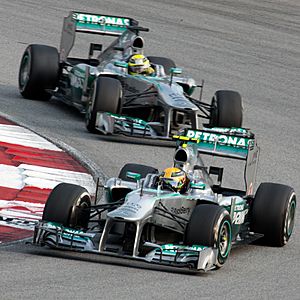
Mercedes-Benz raced in the Formula One world championship in 1954 and 1955. They won two championships with driver Juan-Manuel Fangio but then left the sport.
Mercedes-Benz came back as an engine maker in 1994. They worked with McLaren from 1995. Their engines helped drivers Mika Häkkinen win in 1998 and 1999, and Lewis Hamilton win in 2008. McLaren also won a team championship in 1998.
In 2009, a new Formula One team called Brawn GP used Mercedes engines and won the championships. At the end of that year, Mercedes-Benz bought most of the Brawn GP team. The team was renamed Mercedes GP for the 2010 season and became Mercedes-Benz's main racing team.
After big rule changes in 2014, Mercedes dominated Formula One. They won the drivers' and constructors' titles with Lewis Hamilton and Nico Rosberg. Mercedes won again in 2015 and 2016. From 2017 to 2021, Mercedes continued their success, winning seven championships in a row for both drivers and teams. Lewis Hamilton won in 2014, 2015, 2017, 2018, 2019, and 2020. Nico Rosberg won in 2016. Their winning streak ended in 2021 when Max Verstappen won the drivers' championship.
Formula E Racing
Mercedes, through its EQ branch, joined the Formula E Championship in the 2019–20 season. Their drivers were Stoffel Vandoorne and Nyck de Vries. De Vries won the championship in the 2020-21 season, and Vandoorne won in the 2021-22 season. After winning both driver and team world championships, Mercedes EQ left Formula E.
Mercedes-Benz Logo History
In June 1909, Daimler Motoren Gesellschaft (DMG) registered a three-pointed star and a four-pointed star as trademarks. Only the three-pointed star was used. For DMG, the star showed Gottlieb Daimler's dream of cars being used everywhere: on land, in water, and in the air.
Famous People Who Worked at Mercedes-Benz
- Paul Bracq – A major car designer.
- Adolf Daimler – Chief engineer and Gottlieb Daimler's son. He helped develop the brand logo.
- Béla Barényi – A car safety pioneer who invented the "safety cell" for cars.
- Wilhelm Maybach – An important car pioneer who worked with Gottlieb Daimler.
- Ferdinand Porsche – The founder of Porsche, he worked at Mercedes and helped develop the Kompressor engine.
- Bruno Sacco – Head of Design from 1975 to 1999.
- Rudolf Uhlenhaut – His designs included the famous "Silver Arrows" racing cars.
- Juan Manuel Fangio – A five-time Formula 1 World Champion.
- Michael Schumacher – A seven-time Formula 1 World Champion, he drove for Mercedes in the 80s and then in their Formula One Team from 2010 to 2012.
- Lewis Hamilton – A seven-time Formula 1 World Champion. He has driven for Mercedes in Formula One since 2013 and holds records for most pole positions and race victories. He has been connected to Mercedes since he was 13 years old.
- Nico Rosberg – The 2016 Formula 1 World Champion. He drove for Mercedes from 2010 to 2016 and won all his races and pole positions with them.
- Toto Wolff – The CEO and Team Principal of the Mercedes-AMG Petronas F1 Team.
Cool Innovations by Mercedes-Benz
Mercedes-Benz has introduced many new technologies in its cars over the years:
- The internal combustion engine car was developed by Benz and Daimler & Maybach in 1886.
- Daimler invented the honeycomb radiator, which is still used in water-cooled vehicles today.
- The "drop chassis" was a new car design that lowered the car's body between the wheels. This made cars more stable.
- The first passenger car with brakes on all four wheels (1924).
- In 1936, the Mercedes-Benz 260 D was the first diesel-powered passenger car.
- Mercedes-Benz was the first to offer direct fuel injection in the Mercedes-Benz 300SL Gullwing.
- The "safety cage" or "safety cell" with front and rear crumple zones was first developed by Mercedes-Benz in 1951. This made cars much safer.
- In 1959, Mercedes-Benz patented a device to stop drive wheels from spinning. In 1987, they introduced a traction control system that used this idea.
- An anti-lock braking system (ABS) was first offered on the W116 450SEL 6.9. It became standard on the S-Class starting in 1979.
- Airbags were first introduced in Europe in the 1981 S-Class.
- Mercedes-Benz was the first to use pre-tensioners for seat belts in the 1981 S-Class. These tighten the belt quickly in a crash to keep you safe.
- In September 2003, Mercedes-Benz introduced the world's first seven-speed automatic transmission called '7G-Tronic'.
- Electronic Stability Programme (ESP) and brake assist were also developed and first used in passenger cars by Mercedes-Benz.
- Mercedes-Benz created a system called Pre-Safe to detect an upcoming crash. It prepares the car's safety systems, like tightening seat belts and closing windows, to protect people inside.
- The M133 engine in the Mercedes-Benz A45 AMG was, as of June 2013, the most powerful four-cylinder turbocharged engine in a production car.
Mercedes-Benz won the Safety Award at the 2007 What Car? Awards.
Robot Cars
In the 1980s, Mercedes built the world's first robot car with a team from a German university. In 1995, a self-driving S-Class Mercedes drove a long trip from Munich to Copenhagen and back. On highways, the robot car reached speeds over 175 km/h.
In October 2015, the company showed the Vision Tokyo, a self-driving electric van. It was designed to be a "chill-out zone" in busy city traffic.
Car Tuners
Some companies, like Brabus and Renntech, change Mercedes-Benz cars to make them perform better or look more luxurious. AMG is Mercedes-Benz's own division that makes high-performance versions of most Mercedes-Benz cars. The 2009 SLS AMG was the first car completely designed by AMG.
Sponsorships
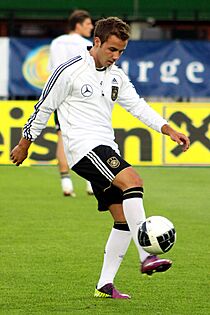
Mercedes-Benz used to sponsor the Germany national football team until 2018. They also sponsor the Bundesliga club VfB Stuttgart. Until June 2023, their stadium was called the Mercedes-Benz Arena.
Mercedes-Benz also had the naming rights for the Caesars Superdome, an American football stadium in New Orleans, from 2011 to 2021. On August 24, 2015, Mercedes-Benz was announced as the naming rights sponsor for the Atlanta Falcons' new stadium, Mercedes-Benz Stadium, which opened in August 2017. Mercedes-Benz's US headquarters are in Atlanta.
Mercedes-Benz worked with the English magician Dynamo to create a video called "Dynamo vs Coulthard." Formula One driver David Coulthard drove Dynamo around a track. Then, Dynamo successfully drove the same car blindfolded.
To promote the video game Mario Kart 8, Nintendo and Mercedes-Benz partnered up. Three Mercedes-Benz cars (the 2014 Mercedes-Benz GLA, the 1957 SL 300 Roadster, and the 1934 W25 Silver Arrow) were added as karts in the game.
Mercedes-Benz was also an official sponsor of the AFF Mitsubishi Electric Cup 2022.
See also
 In Spanish: Mercedes-Benz para niños
In Spanish: Mercedes-Benz para niños


